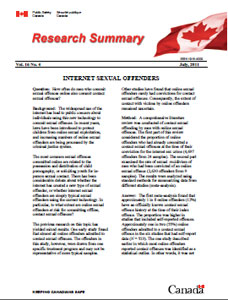Internet Sexual Offenders
Research summary
Vol. 16 No. 4
July 2011
Question
How often do men who commit sexual offences online also commit contact sexual offences?
Background
The widespread use of the internet has lead to public concern about individuals using this new technology to commit sexual offences. In recent years, laws have been introduced to protect children from online sexual exploitation, and increasing numbers of online sexual offenders are being processed by the criminal justice system.
The most common sexual offences committed online are related to the possession and distribution of child pornography, or soliciting youth for in-person sexual contact. There has been considerable debate about whether the internet has created a new type of sexual offender, or whether internet sexual offenders are simply typical sexual offenders using the current technology. In particular, to what extent are online sexual offenders at risk for committing offline, contact sexual offences?
Method
A comprehensive literature review was conducted of contact sexual offending by men with online sexual offences. The first part of this review considered the proportion of online offenders who had already committed a contact sexual offences at the time of their conviction for the internet sex crime (4,697 offenders from 24 samples). The second part examined the rate of sexual recidivism of men who had been convicted of an online sexual offence (2,630 offenders from 9 samples). The results were analyzed using standard methods for summarizing data from different studies (meta-analysis).
Answer
The first meta-analysis found that approximately 1 in 8 online offenders (12%) have an officially known contact sexual offence history at the time of their index offence. The proportion was higher in studies that included self-reported offences. Approximately one in two (55%) online offenders admitted to a contact sexual offence in the six studies that had self-report data (N = 523). The one study described earlier in which most online offenders reported contact offences was identified as a statistical outlier. In other words, it was not representative of the results found in other studies using similar research methods.
The second meta-analysis revealed that 4.6% of online offenders committed a new sexual offence of some kind during a 1.5 to 6-year follow-up; 2.0% committed a contact sexual offence and 3.4% committed a new child pornography offence. The total (4.6%) is less than the sum because some offenders committed both contact and child pornography offences. Overall, these rates are meaningfully lower than the rates of sexual recidivism found among typical sexual offenders (approximately 10% after 5 years).
The results of the two quantitative reviews suggest that many online offenders resemble typical sexual offenders. The results also suggest that there may be a distinct subgroup of online-only offenders who pose relatively low risk of committing contact sexual offences in the future.
Policy implications
- Correctional policies for online sexual offenders should be primarily based on their known offences, not on their risk for contact sexual offending. The overall risk of contact sexual offending among online sexual offenders is low, being roughly the same as the risk of
sexual crime among general offenders (i.e., offenders with no prior convictions for sexual offences). - Given that approximately half of online sexual offenders have histories of contact sexual offending, policies for online sexual offenders should be responsive to their likelihood of contact sexual offending. Some online offenders will benefit from the specialized treatment and supervision normally accorded to typical sexual offenders. However, many are very low risk to commit a contact sexual offence; consequently, directing intensive services towards these offenders may not be the best use of limited resources.
- Specialized risk assessment procedures need to be developed for online sexual offenders. Most of the existing sexual offender risk assessment tools assume a real, identifiable victim, and cannot be applied to offenders whose only offences involves virtual images. Furthermore, the low sexual recidivism rates of online offenders suggests that existing risk assessment tools would over-estimate the risk of sexual recidivism among online offenders.
Source
- Seto, M.C., Hanson, R. K., & Babchishin, K. M. (2011). Contact sexual offending by men with online sexual offenses. Sexual Abuse: A Journal of Research and Treatment, 23, 124-145.
For further information
R. Karl Hanson, Ph.D.
Corrections Research
Public Safety Canada
340 Laurier Avenue West
Ottawa, Ontario K1A 0P8
Tel (613) 991-2840
Fax (613) 990-8295
e-mail karl.hanson@ps-sp.gc.ca
- Date modified:
 PDF (720KB)
PDF (720KB)